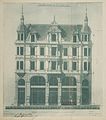House Kaiserstraße 40 (Heilbronn)
The house at Kaiserstraße 40 in Kaiserstraße in Heilbronn was a neo-baroque building built in 1897 according to plans by the architect Heinrich Stroh . It was an example of the “pompous, elaborate style of the so-called founding years at the turn of the century in Heilbronn.” It was located in one of the most striking locations in Heilbronn city center, namely at the tram junction at Kiliansplatz, and was therefore often depicted. The house was destroyed in the air raid on December 4, 1944 . In 1986 the Kilians Café was built in its place according to plans by the city planner and architect Michael Trieb .
description
Pre-war construction
The office building belonged to the family of Adolph Grünwald , one of the most famous Heilbronn families of the Jewish faith. The house was built according to plans by the architect Heinrich Stroh, who also provided the designs for the house at Wilhelmstrasse 68 (1898) and the residential and commercial buildings at Olgastrasse 50 and 54 (1902/03).
The building was designed in the neo-baroque style , occasionally with classical elements. The structure of the bel étage and the 2nd floor showed itself to be “pompous” by a colossal arrangement . The windows on the first floor were designed in Art Nouveau style.
The house was one of the "three pillars of Kiliansplatz" because the house, built in 1897, had tower structures that were supposed to correspond with the turrets of the two opposite houses 23 1/2 and 25.
The later owners Reinhold Jooß and Albert Sichler arranged for redesign. Jooß had changes made to the shop windows, which the art blacksmith August Stotz helped to design. Sichler had the shop premises changed. On November 2, 1909, one of the first cinemas in Heilbronn opened at Kaiserstraße 40, the Viktoria Cinematograph , which only existed until 1913. Up until 1931 there was a shoe store in the house, after which it moved to Kaiserstraße 6. In the early 20th century, the Carl Bek art dealer, the Julius Asch watch store and, on one of the upper floors, the men's tailor Eugen Möhle were also located in this building. In 1931, the A. Gummersheimer company, men's and women's clothing and woven goods, resided at Kaiserstrasse 40 and 42. A. Gummersheimer was also located at Lohtorstrasse 32 for a time. The Max Bräunling flower shop was also located in the building until 1944.
Post-war construction
In the post-war period, Reinhold Jooss initially had the destroyed building replaced with a one-story shop. Projects of the later owners Hans and Lina Bergdoll for a full construction according to plans by Kurt Marohn were not approved.
According to plans by the Stuttgart city planner and architect Michael Trieb , the current “Kilianscafé” building was finally built in 1986.
Individual evidence
- ↑ a b c Helmut Schmolz, Hubert Weckbach (ed.): Heilbronn with Böckingen, Neckargartach, Sontheim. The old city in words and pictures . (Volume 2.) Anton H. Konrad Verlag, Weißenhorn 1967 (publications of the archive of the city of Heilbronn, 15). No. 14, p. 16: Kiliansplatz between 1931-1934
- ↑ z. B. as the title motif for Uwe Jacobi: Heilbronn. A lost cityscape , Wartberg Verlag, Gudensberg-Gleichen 2000.
- ↑ Hans Franke : History and Fate of the Jews in Heilbronn. From the Middle Ages to the time of the National Socialist persecution (1050–1945). Heilbronn City Archives, Heilbronn 1963, ISBN 3-928990-04-7 ( PDF, 1.2 MB ), p. 93 and p. 208.
- ↑ Chronicle of the Heilbronner Cinemas on Heilbronnerkinos.wordpress.com
- ↑ Gerhard Schwinghammer and Reiner Makowski, Die Heilbronner Strasseennamen, Silberburg-Verlag Tübingen 2005, ISBN 978-3-87407-677-7 , p. 68.
- ↑ [1]
- ^ Chronicle of the City of Heilbronn 1952–1957, pp. 229 and 377. The flower shop existed from around 1918/19 and went out in 1956.
- ↑ Michael Trieb, Alexander Schmidt, Stephan Börries, Barbara Grunwald, Barbara Holub, Matthias Kumkar, Seog-Jeong Lee, Ruth Schaufler, Thomas Utsch, Jochen Siebenrock: Stadtbildrahmenplanung Heilbronn , Stuttgart 1988, p. 106.
- ^ City of Heilbronn, city planning office (ed.): Heilbronn: Modern urban design - development of the city 1945-1990. Druck Mokler, Heilbronn 1991 (exhibition by the Heilbronn City Planning Office - on the occasion of the 1250 years of Heilbronn), p. 54.
Coordinates: 49 ° 8 '30.2 " N , 9 ° 13' 12.9" E





